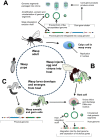Polydnaviruses as symbionts and gene delivery systems
- PMID: 22792063
- PMCID: PMC3390406
- DOI: 10.1371/journal.ppat.1002757
Polydnaviruses as symbionts and gene delivery systems
Conflict of interest statement
The authors have declared that no competing interests exist.
Figures


References
-
- Luria SE, Darnell JE, Baltimore D, Campbell A. General virology. 3rd edition. New York: John Wiley & Sons; 1978. 578
-
- Cann AJ. Principles of molecular virology. 3rd edition. San Diego: Academic Press; 2001. 337
-
- Strand MR, Drezen J-M. Family polydnaviridae. In: King AMQ, Adams MJ, Carstens EB, Lefkowitz EJ, editors. Virus taxonomy: ninth report of the international committee on taxonomy of viruses. Amsterdam: Elsevier; 2012. pp. 237–248.
-
- Strand MR. Polydnaviruses. In: Asgari S, Johnson KN, editors. Insect virology. Norfolk, UK: Caister Academic Press; 2010. pp. 171–197.
-
- Beckage NE. Polydnaviruses as endocrine regulators. In: Beckage NE, Drezen J-M, editors. Parasitoid viruses symbionts and pathogens. San Diego: Academic Press; 2012. pp. 163–168.
Publication types
MeSH terms
Grants and funding
LinkOut - more resources
Full Text Sources

